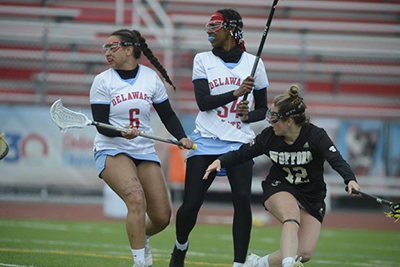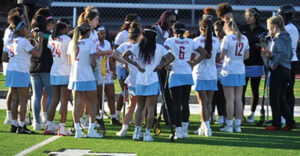
How some historically Black colleges and universities’ athletic departments are making a play to diversify their sports’ repertoires, and what that really means.
Written By Donovan Dooley
(Source NewsOne):

For more than a century, historically Black colleges and universities (HBCUs) have been pioneers in presenting opportunities for Black people to help them grow and thrive, in particular.
These opportunities have not only existed in the classroom but also on the playing field. HBCU sports programs were critical in producing Hall of Fame athletes like NFL running back Walter Payton and NBA guard Earl “The Pearl” Monroe. Black colleges — and were critical in establishing football and basketball as the so-called “traditionally Black” sports that they are today — also gave chances to many student-athletes who at one point in time were not allowed to compete at traditional powerhouse universities and who were overlooked by coaches at bigger universities simply because of the color of their skin.
Now, these institutions are slowly but surely increasingly allocating resources to expand their athletic reach in an effort to uphold the tradition of providing unique opportunities for Black student athletes — by tracking a course through competitive sports that some might consider to be nontraditional when it comes to Black folks.
This year alone, Fisk University just became the first HBCU to begin a gymnastics program, Saint Augustine University launched the first HBCU women’s rowing team, and Morgan State University made plans to bring rugby to its campus for the first time.
The impact of these schools incorporating more sports into their athletic budgets and campus culture cannot be understated. Particularly because it eliminates the choice Black student-athletes typically must make between attending an HBCU or going to a predominately white institution in order to play the sport they love.
“There’s a lot of students who are actually choosing HBCUs over rugby and we don’t think that should be the case,” Carille Gutherie, President of the James G. Robertson & Clive Sullivan Rugby Foundation, told NewsOne during a recent conversation.
“Sports like rugby have massive potential on HBCU campuses,” Gutherie, whose organization helps HBCUs start rugby teams on campus, added.
“It’s almost critical, especially when you look at female participation in sports,” Gutherie said. “A lot of HBCUs have higher female enrollment and lower participation in NCAA varsity sports numbers.”
Gutherie emphasized the importance of continuing to push for access to more sports at historically Black colleges.
“I think if we can show HBCU campuses that rugby is a low-cost option that’s welcoming to everyone, I really think that they can flourish,” Gutherie added.
Gutherie, who called rugby an “outlier sport,” and her team have already established men’s and women’s teams at Howard University, her alma mater. And in addition to Morgan State entering the rugby landscape, Gutherie said her organization is in the process of bringing the sport to other HBCUs including Bowie State University and North Carolina A&T State University, the nation’s largest HBCU.
Fisk gymnastics Coach Corrine Tarver — a former U.S. National Team member; the first ever Black gymnast at the University of Georgia; member of Georgia’s first two NCAA national championship teams; and NCAA champion who won the All Around and Floor Exercise competitions in 1989 — made similar points during a recent conversation.
“It’s great to be the first HBCU,” Tarver said of bringing a new sport to a school like Fisk. “What it does is open up opportunities for girls who want to have an HBCU experience and do gymnastics at the same time because it just wasn’t something that was an option before,” Tarver told NewsOne. “It’s also an opportunity to give a place for Black and Brown girls to land in because sometimes the gymnasts that are Black and Brown are looked at as not having the ideal body type or they don’t have the right lines or things of that nature. So if they are not the superstars they have a tendency to get overlooked a little. This is an opportunity for them to have a place because I understand how that feels, and I invite those girls to come on our team.”
Tarver said she hopes other HBCUs see what Fisk is doing in an inspirational light.
“My hope is that when they see us, then other HBCUs will want to add,” Tarver said.
While the efforts of these trailblazers are admirable, their duties do not come without challenges.
“There are such a small pool of candidates, you know, to come to Delaware State University,” the school’s Head Women’s Lacrosse Coach Pam Jenkins told NewsOne. “That’s because it’s a predominantly white sport. When it comes to those players that could put that program over the edge. They’re looking at whether it’s the funding for your program or they’re looking at the rankings of your program. And unfortunately, at the moment, HBCU women’s lacrosse programs have not been as successful as some other programs. So we find ourselves trying to go after some of these top African-American players and we’re losing the battles with the Richmonds and some of the other programs who have seen success.”
Undoubtedly, it’ll take time before HBCU programs can build consistent success in their new sporting endeavors. Like other sports at HBCUs, the fact that these institutions have been severely underfunded for decades could similarly adversely impact the new budding sports. However, for Jenkins and the Hornets at Delaware State, progress has already been made despite natural challenges and a notable racial profiling incident earlier this year.
Since Jenkins took over, Delaware State’s women’s lacrosse program has grown more than three times in size and was able to successfully recruit a top-ranked player in the class of 2022.
“We want to be the first HBCU Women’s Lacrosse program that is ranked in the country. That’s what we’re striving towards. That’s what we’re busting our butts toward, to be a ranked program,” Jenkins said. “I’m hoping to draw more players of color to want to come to an HBCU. Where we’re seen as equals to our counterparts and not a step-down, you know, I want us to be seen as the destination and not the afterthought.”
The journey to success for these programs may be unique considering their nuance in the HBCU community, but the need for growth and accessibility remain common keys to their sustainability.
“I think what we’re trying to do on our end is bring players in where they’re like, ‘oh, wow, look, she looks like me. She’s wanting to help me grow and is introducing me to the sport’. And then ‘Wow I’m actually pretty good at it,’” Jenkins said. “I think just having the accessibility is huge and branching out in non-traditional areas is super important.”


Be the first to comment